Search results for: 'Roman an'
-
 Roman gaming pieces from the Rhineland
Roman gaming pieces from the Rhineland6 Roman glass gaming pieces and 8 other Roman artefacts. Finds from the Roman city of Novaesium, today's Neuss in Germany.
Price: on request Roman artefacts from the Rhineland
Roman artefacts from the RhinelandFragments of Roman pottery vessels, bronze and glass fragment, as well as a piece of a mosaic. Finds from the Roman city of Novaesium, today's Neuss in Germany.
Price: on request Roman bronze fibula
Roman bronze fibulaBrooch from the earlier Roman imperial period with a nice patina. This type of brooch was common in Central and Northern Europe. This very piece is from the Roman city of Novaesium, today's Neuss in Germany.
Price: on request Roman anchor fibula
Roman anchor fibulaMagnificent silver brooch from the Roman Imperial period. Such fibulae were made in the Danube area Roman provinces.
Price: on request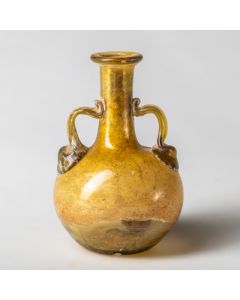 Roman glass bottle with handles
Roman glass bottle with handlesThe glass impresses with its elegant shape. Made in one of the Roman glass factories in the eastern Mediterranean during the Late Imperial period.
Price: on request Roman earrings with shield
Roman earrings with shieldMatching pair of gold jewellery with semi-spherical shield. From the Roman Imperial period.
Price: on request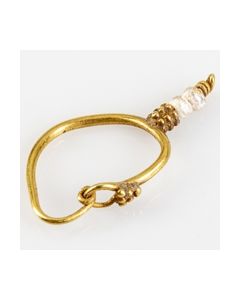 Roman gold earring with pearls
Roman gold earring with pearlsFine specimen from the eastern provinces during late Roman Imperial times. From the collection of the orientalist N. Giron.
Price: on request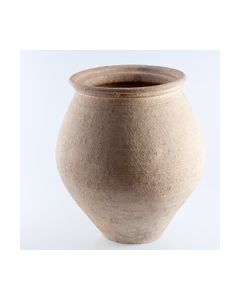 Riesige römische Graburne
Riesige römische GraburneVollständig erhalten, Höhe 300mm, Duchmesser 270mm.
Price: on request Roman gold earrings with faience beads
Roman gold earrings with faience beadsBelonging pair of jewellery made of gold, each decorated with shield and bead. From the Roman provinces of the eastern Mediterranean, made during the Imperial period.
Price: on request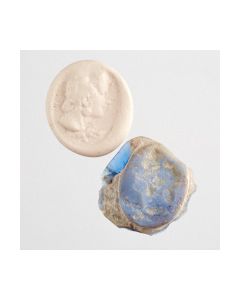 Roman intaglio with a young woman
Roman intaglio with a young womanMiniature work in a colourful glass paste changing from bright blue to an opaque light blue. The intaglio from Roman times exhibits the portrait head of a young woman.
Price: on request Roman medallion with Fortuna
Roman medallion with FortunaThe piece of gold jewellery could be worn as a pendant on the ear or on a necklace. The relief shows Fortuna, the goddess of fortune and fate, with her typical attributes. Made between the 1st and 3rd century.
Price: on request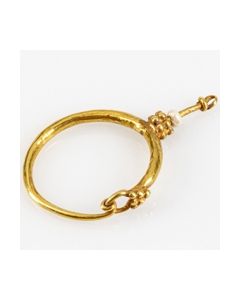 Roman gold earring
Roman gold earringFine specimen from the eastern provinces during late Roman Imperial times. From the collection of the orientalist N. Giron.
Price: on request Roman gold ring with intaglio
Roman gold ring with intaglioNice fingerring with a glass paste showing a standing figure. Characteristic type for the 1st century CE, early Roman Imperial period.
Price: on request Two Roman glass unguentaria
Two Roman glass unguentariaThe early imperial perfume bottles are from the eastern Mediterranean. Acquired in 1974 from art dealer Albrecht Neuhaus.
Price: on request Large ancient spindle whorl
Large ancient spindle whorlCeltic to Roman times. Massive clay object, 100mm diameter.
Price: on request Roman knee brooch from Britannia
Roman knee brooch from BritanniaWell preserved example of this important fibula type that was introduced to Britain by Roman troop movements from the Rhineland. This specimen was already produced locally in Britannia province. It was published in two books on ancient fibulae.
Price: on request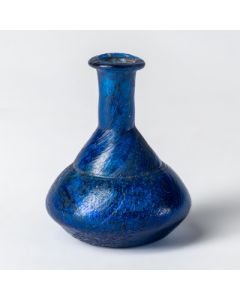 Roman ointment bottle of bright blue glass
Roman ointment bottle of bright blue glassA strikingly colourful bottle for oil or perfume. From the Roman Imperial period, made in a province of the eastern Mediterranean.
Price: on request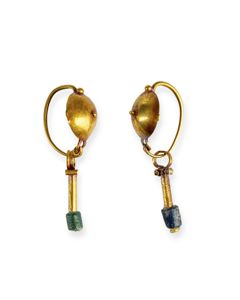 Roman earrings with shield
Roman earrings with shieldMatching pair of gold jewellery with semi-spherical shield and coloured glass bead. From the Roman Imperial period.
Price: on request Roman clay statuette
Roman clay statuetteClay figure of a man with a spherical object in front of his stomach. From the Roman province.
Price: on request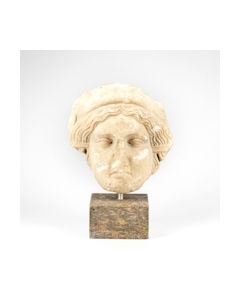 Large Roman marble head of a woman
Large Roman marble head of a womanVery well preserved fragment of a larger group. Ca. 1st - 2nd century AD, Roman Empire. From an old German collection, acquired in 1987 from Helmut Liebert in Krefeld, Germany.
Price: on request Roman silver fibula
Roman silver fibulaInteresting type of brooch from the Roman Imperial period. Nice specimen made of silver.
Price: on request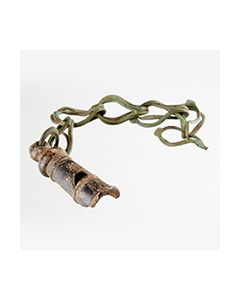 Roman military whistle
Roman military whistleHistorically interesting example of Roman military equipment. Whistles of this type have been used in the 1st to 2nd cent. AD. Their function is not fully understood, yet.
Price: on request Roman military whistle
Roman military whistleHistorically interesting example of Roman military equipment. Whistles of this type have been used in the 1st to 2nd cent. AD. Their function is not fully understood, yet.
Price: on request Roman lentoid glass flask
Roman lentoid glass flaskThe flat bottle has a discoid body with a very long neck. Probably from the Roman province Judaea.
Price: on request Roman square glass bottle
Roman square glass bottleTypical and popular glass vessel type from the Roman Imperial period. From the Heckmann collection.
Price: on request Roman oil lamp showing emperor Claudius
Roman oil lamp showing emperor ClaudiusVery rare depiction of this Roman emperor on a piece of pottery intended for daily use. Very well preserved, worth the exhibition in a museum. Coming with an Art Loss certificate.
Price: on request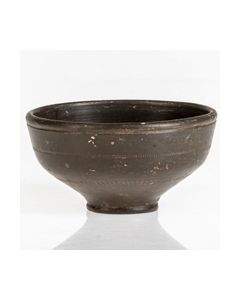 Roman bowl found in Cologne
Roman bowl found in CologneA very similar piece found in Trier which possibly originates from the same workshop is published in Gose, Gefäßtypen der Römischen Keramik im Rheinland. Acquired 1971 from Axel G. Weber Gallery, Cologne, Germany. Said to have been found in Cologne.
Price: on request Bracelet with animal heads
Bracelet with animal headsMassive bronze bracelet dating to Late Antiquity. Animal head shaped terminals.
Price: on request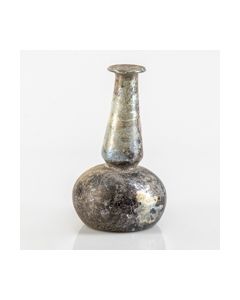 Roman unguentarium
Roman unguentariumThe cosmetic bottle from the Eastern Mediterranean dates to the 1st or 2nd century. A nice piece of ancient glass from the professor Ritschel collection.
Price: on request Roman glass cup
Roman glass cupGlass vessel dating to the 1st century AD. Beautiful iridescent patina. From the professor Ritschel collection.
Price: on request Pannonian trumpet brooch
Pannonian trumpet broochWell preserved Roman silver fibula with curved bow. The type is from the Pannonian provinces of Rome and dates to the 2nd century.
Price: on request Roman intaglio with goddess of victory
Roman intaglio with goddess of victoryThe glass paste features Victoria writing the names of victors in battle on a large shield.
Price: on request Roman intaglio with goddess Nike
Roman intaglio with goddess NikeAttractive white banded orange glass paste. From the Professor Brosch collection of engraved gems.
Price: on request Roman glass paste with young satyr
Roman glass paste with young satyrThe ring insert shows a hybrid being standing on tiptoe, pouring from a shouldered amphora. A prime example of Roman glass pastes in almost perfect condition.
Price: on request Roman intaglio with octopus
Roman intaglio with octopusDecorative insert made of beautiful, green shimmering glass paste, with a rare depiction.
Price: on request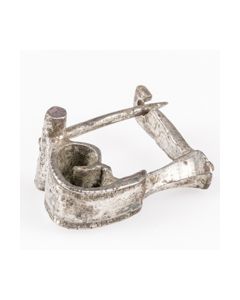 Roman silver fibula from Pannonia
Roman silver fibula from PannoniaInteresting brooch type from the Roman Pannonian provinces. A very similar piece was found near the Roman camp and settlement of Carnuntum in what is now Austria.
Price: on request

